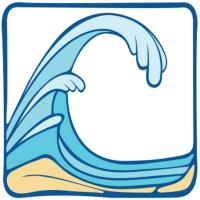Article,
Diagnostic investigation of impulsive pressures induced by plunging breakers impinging on gravel beaches
Coastal Engineering, 57 (3): 252-266 (2010)
DOI: 10.1016/j.coastaleng.2009.09.010
Abstract
This paper presents an integrated investigation of physical processes generating impulsive pressures under the action of plunging breakers impinging on gravel beaches. This work is an extension of a recent investigation which suggested that wave impacts from plunging breakers acting on gravel beaches may be a key mechanism to enhance sediment mobilisation. In particular, comparisons of full scale laboratory measurements against model results from a well-validated phase/depth-resolving numerical model based on the Reynolds-Averaged Navier-Stokes (RANS) equations are presented. This represents the first attempt at comparison with such a tool against observed hydrodynamics on steep (slope~1/8) gravel beaches at prototype scale. In order to understand how impulsive pressures are generated under plunging waves, the numerical model is used to carry out a detailed investigation to examine the role of each of the acceleration terms in the momentum balance. Consistent with prior studies, numerical results show that under plunging breakers the local acceleration (∂u/∂t) alone cannot be used as a proxy for pressure gradients. However, the contribution of the third term (w∂u/∂z) of total acceleration is recognized for the first time and indicates that this term has an important role in both the induced pressure gradient and sediment mobilisation as induced by this particular type of breaking. Furthermore, results suggest that a parameterisation of the pressure gradient in terms of ∂u/∂t+u∂u/∂x, may not suffice when dealing with plunging breakers and hence there is a lack of a suitable parameterisation of this process in the present literature. Thus, for different types of breaking it may be necessary to consider a different characterisation of the pressure gradient toward the parameterisation of sediment transport inside the surf zone. © 2009 Elsevier B.V. All rights reserved.
Tags
- 2010
- from:erick007
- gravelbeach
- hydrodynamics
- impulsivepressure
- numericalmodels
- plungingbreaker
- porousmedia
- pressuregradient
- ransequations
